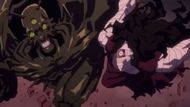This week, One Punch Man Season 3 fell into yet another disaster. Episode 3 had a frame that briefly showed Royal Ripper with feminine features during his fight with Garou. Naturally, screenshots spread fast, but people claimed the studio made the male monster into a woman altogether.
Here is the truth: Royal Ripper is not a female. It was one frame that had a weird moment in the fight. The animators made sure to keep every other frame previously showing him as a male type from the manga, so it was not a redesign in gender. It looks like it was an odd idea on how to create smooth movement from pose to pose. The animators probably stretched the character weirdly when they drew the transitional frames.
What Happened in One Punch Man Season 3 Episode 3

In the third episode of One Punch Man season 3, the conflict between Garou and Royal Ripper took center stage. During their exchange, fans captured a single frame of Royal Ripper that appeared to have somewhat feminine features. However, this particular image was seen for just an instant before reverting back to the mangaka-designated male description in subsequent frames.
As expected of a fanbase with passionate reactions to any hint of issues in animation, the usage of an "androgynous" Royal Ripper, while minor, nonetheless riled up many viewers. A barrage of commentary began flowing throughout various anime communities, where fans were comparing screenshots from the anime to the panels from the source by ONE and Yusuke Murata.
Each of those and all subsequent panels of Royal Ripper were clearly male with the usage of he/him masculine pronouns to describe the character's physicality, while underscoring the grotesque cartoonish nature of the character's manly features.
Understanding Animation Errors

The process of animation involves rendering fluid transitions between keyframes, as part of a concept oriented towards smoothness in animation known as inbetweening. To connect key character poses together, animators will draw frames that exist in between two major poses to help create the illusion of fluid movement. It is worth mentioning that if this technique is done successfully, it creates motion so fluid and seamless.
However, as with any process of complexity, issues can arise in this process. In between frames can sometimes distort character features, as animators can stretch an idea or simply redesign blown-up features. Even though the transitional frames are visually there for milliseconds (frames), they can still "be captured" in captured screenshots.
The controversial frame from One Punch Man season 3 appears to be one of those errors. Instead of the animators wanting to change Royal Ripper's gender, it was viewed as the animation team created an awkward in-between frame that changed the appearance of the character momentarily.
Impact on One Punch Man Season 3

Each new episode of One Punch Man season 3 is receiving new backlash. The Royal Ripper continues to raise legitimate criticisms surrounding the production quality of the anime. Fans who have waited six years for it to return are feeling betrayed by the content.
The anticipated fight between Saitama and Garou presents the season's biggest challenge, as it will require an immaculate quality of animation to appease fans who've been tracking this series for years. The previous episodes have reached below-average standards and have lowered the expectations of a faithful adaptation living up to the original vision.
The Verdict
Did One Punch Man season 3 intentionally turn Royal Ripper into a woman? No. The controversial frame represents an animation error during the inbetweening process rather than a deliberate character redesign.
This incident highlights the broader production issues plaguing the season. Quality control lapses allow such errors to reach final broadcasts. The studio's struggle to maintain consistency concerns fans hoping for improvement in future episodes.
